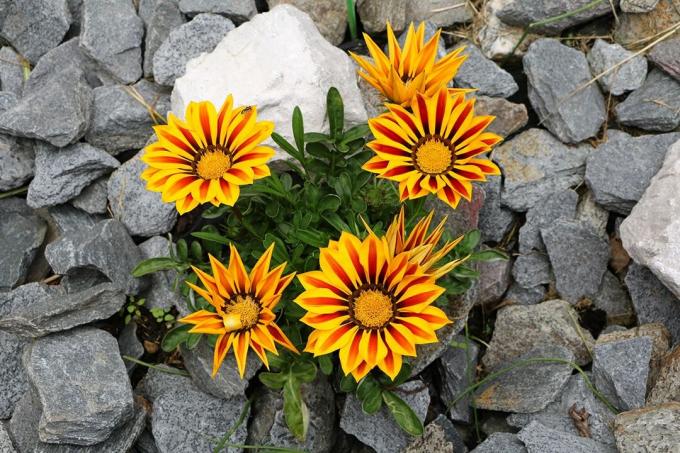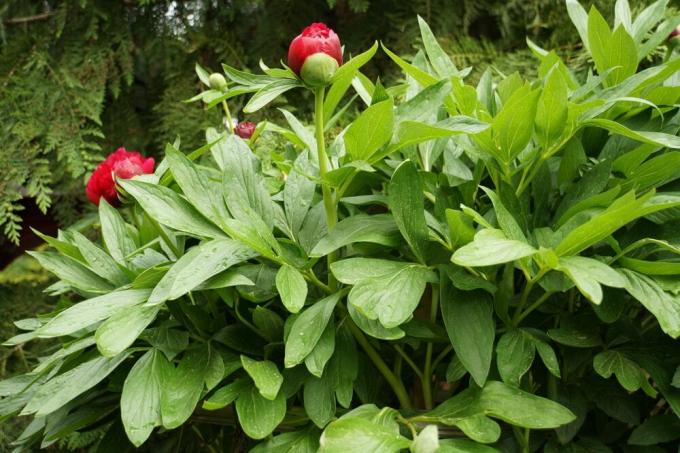

Table of contents
- Location
- soil / substrate
- pots / tubs
- sowing
- Fertilize
- Pour
- Repotting / Transplanting
- Cut
- hibernate
- propagation
- diseases and pests
Thanks to its golden yellow flowers, Californian poppies are particularly decorative and extremely frugal. Hobby gardeners do not need a green thumb to cultivate the pretty plant. Nevertheless, certain conditions should be met in terms of location and care, so that the sleepyhead
Location
Californian poppies love the sun and have a high light requirement, which is why they are best cultivated in full sun. In addition, it needs sun to open its flowers. If, on the other hand, it is cultivated in a semi-shady or shady location, not only does the flowering suffer, because the existing flowers also remain closed.
- full sun
- Ideal in steppe or rock gardens
- Best cultivated over a large area
A notice:
On cloudy days, the sleepy hat keeps its flowers closed, even in full sun.
soil / substrate

In the wild, California poppies prefer to grow in rough and rocky soils, sometimes even in inner-city areas. In the home garden, the lime-tolerant plant feels most comfortable in light loamy or sandy soil. If you want to cultivate the plant in a flower box, it is best to use commercially available potting soil and improve it with quartz sand, expanded clay or lava granules.
- water permeable
- low in nutrients
- Dry
- pH between 5.8 – 7.5
pots / tubs
Yellow poppy is not only a feast for the eyes in the bed, because it is also particularly decorative on the balcony. Fortunately, it can be cultivated in containers without any problems - as long as they meet certain requirements. Pots with a diameter of around 12 centimeters are best suited for this. These should also be sufficiently deep so that drainage can easily be accommodated in them.
sowing
The best time to sow the California poppy is between April and May. It would be perfectly possible to sow it by June, but flowering would then be postponed to the following year. Accordingly, it would also be necessary to bring the Eschscholzia californica safely through the winter. For these reasons, spring sowing is usually the better choice. Since yellow poppies are reluctant to be transplanted and pricked out, they should be sown directly where they are to flower later. The sowing itself is very simple and is as follows:
- Clear the soil of larger roots and stones
- Dig furrows about 1 cm deep
- Sow seeds about 10 cm apart
- Then always keep it moist
- Optimum germination temperature: 15 to 18 degrees Celsius
- Germination time: about 10 to 14 days
A notice:
A topsoil thickness of 25 centimeters is sufficient for the California poppy.
Fertilize
The fertilizing of the golden poppy is basically not necessary, because the nutrients contained in the soil are usually sufficient for the frugal little plant. However, if the soil is particularly poor, fertilization can still be useful. In this case, fertilizing with compost, horn shavings and some rock dust about six weeks after sowing is a good idea. For golden poppies in flower boxes, however, fertilizing is generally recommended, whereby the following should be observed:
- About every 30 days with liquid fertilizer
- Alternatively with long-term fertilizer
- sticks or cones
A notice:
The peony poppy is a very lush growing variety that is happy about a small portion of liquid fertilizer from time to time.
Pour

- More frequent watering necessary
- Check soil surface every few days
- Water as soon as the layer of soil has dried by about 2-3 cm
- Remove excess water after about 20 minutes
Repotting / Transplanting
The gold poppy does not like transplanting at all, which is why this measure is not recommended. It is best sown directly at the location where it is to flower in the future.
Cut
A pruning in itself is not necessary for the California poppy, since it is usually cultivated as an annual plant anyway. However, it is advisable to remove the withered flowers regularly, as this promotes the formation of new flowers. However, if you live in a region with mild winters, you can cultivate the golden poppy as a perennial and leave the dead leaves directly in the bed, so that there is natural winter protection.
hibernate

Californian poppy is hardy down to -10 degrees Celsius and can be cultivated and overwintered as a perennial in regions with mild winters. For this purpose, the withered flowers are removed in autumn and the fallen leaves are cut off close to the ground in late winter. If necessary, the foliage can be used as winter protection, although foliage, straw, brushwood or a reed mat are also very suitable. During the winter, watering is recommended when there is a frost on mild days. With golden poppies in pots, however, the following measures are recommended to get the golden poppies through the winter safely:
- Root ball can freeze through outdoors
- Bring the potted plant to a frost-free winter quarters
- Location can also be dark
- Cut off all plant parts
- Water every now and then
propagation
If you want to multiply the golden poppy, you can do this extremely easily with seeds. There are several methods for doing this: On the one hand, the flowers can simply be left for self-sowing. On the other hand, the seeds can also be bought in stores or harvested yourself. The seeds themselves are found in cylinder-shaped pods that open on the long sides when ripe. As a rule, the small, dark seeds can be harvested in September and then dried and stored.
diseases and pests
Californian poppies are relatively resistant to diseases and pests. Fungal diseases such as powdery mildew can only occur in damp or too cold weather.
 garden editorial
garden editorial I write about everything that interests me in my garden.
Learn more about flowers

Midday gold, Gazania: proper care and wintering
The midday gold, which impresses with its colorful and sun-loving flowers, is one of the most popular perennials for local gardeners. The right tips for caring for and overwintering the Gazania have been put together for you here.

Caring for, overwintering and cutting asters | Instructions
The radiant flowers of the asters enchant every garden as well as in pots, terraces and balconies, depending on the variety, from May until well into autumn. Caring for the perennials is not that difficult if everything is known about wintering and cutting.

Magnificent pier, Astilbe: care instructions from A - Z
Astilbe is very popular in the garden. Still, gardeners need to consider a few things if they want the plants to thrive. In our A-Z care instructions, you will learn everything you need to know about the splendor, from flowering to winter protection.

17 hardy bee-friendly flowers
There has been talk of bee deaths for years. You absolutely need help to survive. Bees are an important part of our ecosystem. Garden owners can also help the small insects with the design of their green oasis.

When do peonies bloom? | Beginning and duration of the flowering period
Peonies are garden perennials that, after a few years, form a veritable sea of flowers in early summer. The individual flowers are long-lasting and are also suitable for cutting. Depending on the variety, they bloom in different colors. But when exactly is the heyday?

Goldtaler plant: care of Pallenis maritima | Is the flower hardy?
The Goldtaler plant is an easy-care balcony plant that impresses with its bright yellow flowers. Although it is often only cultivated as an annual in this country, the perennial plant can also be overwintered without major problems.
